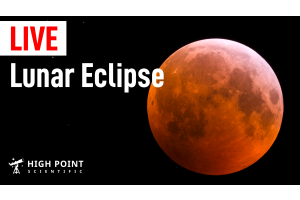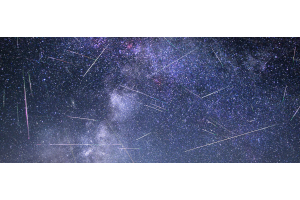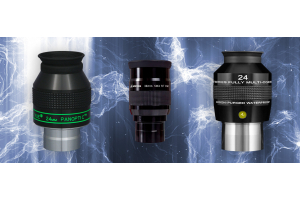
Banner Image: Timelapse composite of the January 2019 total lunar eclipse taken with an 8” Newtonian. Image credit: Jona Krahl
What you need to know
On Thursday, March 13th, 2025, there will be a Total Lunar Eclipse. This event is of particular interest as it will be the first eclipse of the 2025 season. If you want to learn more about the upcoming eclipse season, check out our full 2025 Eclipse Guide!
When Can YOU View this Event?
The upcoming total lunar eclipse will begin on March 13th, 2025, at 11:57 pm ET and end on March 14th, 2025, at 06:00 am ET. The total duration will be approximately 6 hours, with the Moon being completely shaded (100% coverage) by the Earth's umbral shadow for just over an hour.
More than a billion people throughout North, Central, and South America will have the chance to view this breathtaking celestial event, which will not require specialized gear. However, with a pair of binoculars or telescope, you’ll be able to experience the vibrant colors of the lunar eclipse in vivid detail. Be sure to check your local weather conditions before the event to ensure visibility and use the viewing chart in the following section to find out when you can view this event in your time zone![1]

Credit: timeanddate.com
[1] "March 13–14, 2025 Total Lunar Eclipse," Eclipses, Time and Date, accessed December 18, 2024, https://www.timeanddate.com/eclipse/lunar/2025-march-14.
Viewing Chart
| Time Zones |
|---|
| Penumbral Stage Begins |
| Partial Stage Begins |
| Umbral Stage Begins |
| Peak of Eclipse |
| Umbral Stage Ends |
| Partial Stage Ends |
| Penumbral Stage Ends |
| UTC | Atlantic | Eastern | Central | Mountain | Arizona | Pacific | Alaska |
|---|---|---|---|---|---|---|---|
| Mar. 14th 3:57 am |
Mar. 14th 12:57 am |
Mar. 13th 11:57 pm |
Mar. 13th 10:57 pm |
Mar. 13th 9:57 pm |
Mar. 13th 8:57 pm |
Mar. 13th 8:57 pm |
Mar. 13th 7:57 pm |
| Mar. 14th 5:09 am |
Mar. 14th 2:09 am |
Mar. 14th 1:09 am |
Mar. 14th 12:09 am |
Mar. 13th 11:09 pm |
Mar. 13th 10:09 pm |
Mar. 13th 10:09 pm |
Mar. 13th 9:09 pm |
| Mar. 14th 06:26 am |
Mar. 14th 3:26 am |
Mar. 14th 2:26 am |
Mar. 14th 1:26 am |
Mar. 14th 12:26 pm |
Mar. 13th 11:26 pm |
Mar. 13th 11:26 pm |
Mar. 13th 10:26 pm |
| Mar. 14th 6:58 am |
Mar. 14th 3:58 am |
Mar. 14th 2:58 am |
Mar. 14th 1:58 am |
Mar. 14th 12:58 am |
Mar. 13th 11:58 pm |
Mar. 13th 11:58 pm |
Mar. 13th 10:58 pm |
| Mar. 14th 7:31 am |
Mar. 14th 4:31 am |
Mar. 14th 3:31 am |
Mar. 14th 2:31 am |
Mar. 14th 1:31 am |
Mar. 14th 12:31 am |
Mar. 14th 12:31 am |
Mar. 14th 11:47 am |
| Mar. 14th 8:47 am |
Mar. 14th 5:47 am |
Mar. 14th 4:47 am |
Mar. 14th 3:47 am |
Mar. 14th 2:47 am |
Mar. 14th 1:47 am |
Mar. 14th 1:47 am |
Mar. 14th 12:47 am |
Mar. 14th 10:00 am |
Mar. 14th 7:00 am |
Mar. 14th 6:00 am |
Mar. 14th 5:00 am |
Mar. 14th 4:00 am |
Mar. 14th 3:00 am |
Mar. 14th 3:00 am |
Mar. 14th 2:00 am |
Please note: Exact times for each stage will vary depending on local time keeping practices. For more precise event times, use a celestial simulator like Stellarium.
What will the Moon look like?
During a Total Lunar Eclipse, the Moon is entirely shaded by the central and darkest part of Earth’s shadow, also known as the "umbral" shadow. Viewers in the path of the eclipse will watch the Moon transition through seven distinct stages. During the first stage, the passes into Earth’s lighter “penumbral” shadow, making it appear slightly darker than usual. During the second stage, the Moon begins moving into the Earth’s darker umbral shadow, which will slowly fill the lunar surface. As the second stage concludes, the eclipse will move into the third stage, with the umbral shadow fully covering the lunar surface. During this stage, the Moon will display beautiful shades of orange and red. While each lunar eclipse is unique, the third stage, also known as the totality of the eclipse, typically will last for an hour or longer. For the upcoming total lunar eclipse, totality will last for a total of 65 minutes, after which the Moon will begin to move back through the partial and penumbral stage.
Lunar photographers and astrophotographers should take note of this event as it will be an excellent chance to capture a stunning lunar photo! If you want to learn more about imaging the Moon, check out our Lunar Eclipse Imaging Guide!
Learn More About Lunar Eclipses
What is a lunar eclipse, and how often do they occur? If you want to know the answers to these questions and more, dive into our AstronomyHub! Our AstronomyHub is constantly growing with articles, guides, and so much more! Check out a curated list of our best Lunar Eclipse Articles below!
Click the arrow above to see MLA, APA, and Chicago Manual of Style citations.
MLA:
Daniel Burchett. "Eclipse Alert: Total Lunar Eclipse," AstronomyHub, High Point Scientific, 15 Jan. 2025, https://www.highpointscientific.com/astronomy-hub/post/total-lunar-eclipse-march-2025.
APA:
Burchett, D. (2025, January 15). Eclipse Alert: Total Lunar Eclipse. High Point Scientific. https://www.highpointscientific.com/astronomy-hub/post/total-lunar-eclipse-march-2025
Chicago Manual of Style:
Bibliography:
Daniel Burchett "Eclipse Alert: Total Lunar Eclipse," AstronomyHub (blog), High Point Scientific, January 15th, 2025. https://www.highpointscientific.com/astronomy-hub/post/total-lunar-eclipse-march-2025.
Footnote:
Daniel Burchett "Eclipse Alert: Total Lunar Eclipse," AstronomyHub, High Point Scientific, January 15th, 2025, https://www.highpointscientific.com/astronomy-hub/post/total-lunar-eclipse-march-2025.

Learn More
Interested in diving deeper into the world of astronomy and astrophotography? Not sure where to begin? Check out our Astronomy Hub!









